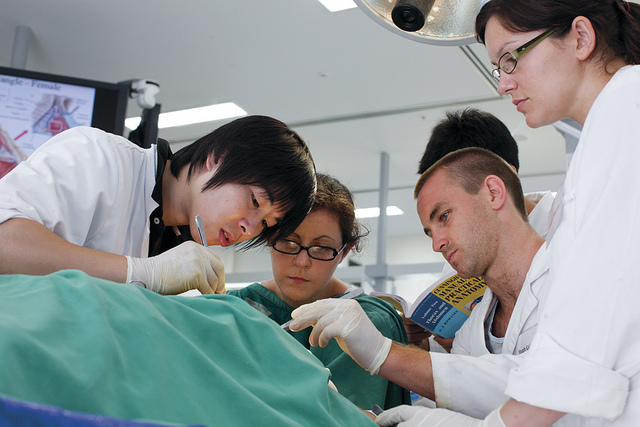Low number of Hispanic medical students, a real issue

 By John Benson, Saludify
By John Benson, Saludify
• The number of American doctors registered Hispanic: 53,075
• The ratio doctors/Hispanic population: 1,004,635/52 million
• Percentage of Hispanics registering for medical school: 8%
So what are the challenges keeping Latinos out of medical school?
Soon to be published Academic Medicine article Racial and Ethnic Minority Medical Students, Perceptions of and Interest in Careers in Academic Medicine concluded most medical students expressed an early interest in academic medicine but lacked clarity about the career path.
Among these, 29 percent of Hispanic medical students described both individual and institutional challenges to academic careers in medicine.
These challenges included:
Lack of role models for Hispanic medical students
Perhaps this is the most obvious deterrent to potential Latino medical students but don’t discount a young child’s aspiration as powerful motivation for a career path.
“I suppose it’s not surprising since certainly at the medical school, medicine has historically been a profession for the privileged,” USC’s KECK School of Medicine Associate Professor of Obstetrics and Gynecology Raquel Arias, MD told Saludify. “Therefore, it’s not surprising, although still sad, that a service profession is populated by people who are so very different from the people they will be serving. So if all the physicians you see look very similar and don’t look like you, then the odds you’ll consider that a viable profession is low.”
For proof look no further than second generation American and current medical student Humberto Avila, who decided to pursue medicine after watching his cousin become a doctor in Mexico.
“I’m fluent in Spanish, and I feel like I would be doing a disservice if I was not working in a Spanish-speaking community,” Keck School of Medicine of USC student Avila told Saludify.
Having a close family member clear the path before him was a powerful influence on his decision to pursue medicine and in turn impact a possible future generation of physicians.
Debt is a bigger challenge for Hispanic medical students
Avila said the high cost of medical school is one of the biggest factors he runs into as a member of Latino Medical Student Association, which is a medical student-based group promoting health education and healthcare career recruitment in Latino communities.
At a glance, according to a Bloomberg report:
- $50,000 was the median tuition and fees at private medical schools
- $170,000 was the median education debt for 2012 medical-school graduates (not including interest)
Throughout his community outreach, Avila said one barrier is the delayed gratification.
Many students aren’t comfortable waiting until they’re in their 30s before finally getting out of college and starting a career.
Recruitment – Hispanics?

Low recruitment efforts for Hispanic medical students is still an issue.
Another recent study on medical students indicated problems recruiting underrepresented minorities into the healthcare profession.
Suggested Hispanic medical student recruitment solutions in the report included creating a more collaborative learning environment, a pass-fail evaluation system and making emphasis on student diversity.
Overall, the study said the idea of “camaraderie and sense of trust amongst peers was perceived as an intangible benefit of a sense of community that dissolved any residual desire for competitiveness.”
However, Dr. Arias said there’s a larger issue that hampers conventional recruitment efforts for Hispanic medical students.
“Until [Latino medical students] have the groundwork of education, until they learn the things in elementary school that make them strong high school students and from there getting into good colleges, that prepare them for professional careers, we can do all of the outreach and it doesn’t seem to make one bit of difference,” Arias said.
“The real problem is, medical schools can’t fix this. Medical schools can be willing to take anybody who has a chance of success, but until college and high schools educate students equitably, we’ll have an inadequate pool of students to reach from the medical schools.”
Why do we need more Hispanic medical students?
According to the Center for Studying Health System Change’s study in 2010, 49 percent of physicians reported that language or cultural barriers affect their ability to provide quality care.
The data shows Hispanics who lack English proficiency in underserved communities are choosing the emergency rooms, which often provide inadequate care, over a long-term primary healthcare provider that’s most likely not a Latino physician.
As part of the translation hurdles there are cultural idiosyncrasies.
• Semantics: Whereas a patient may say their heart hurts, a doctor may interpret this as a cardio issue when it’s actually meant to as an emotional pain.
• Medication sharing: A common practice in Latino culture is the sharing of medications due to a belief of a shared illness. More education and understanding of Latino habits is required to provide a better medical care.
• Spirituality: According to the Journal of General Internal Medicine, nearly 70 percent of Latinos think that spiritual healing is very important in maintaining health and wellbeing, but this is often lost in translation.
What now for Hispanic medical students?
Over the past year, according to the Association of American Medical Colleges, a record number of Hispanic/Latino students (3,701) applied to medical school. That marked a new high in enrollment with 1,731 Hispanic/Latino students. However, this is far from solving the issue.
“There is still a lot more to be done,” Avila said.
“When I do talk to students who are Latino and don’t know what they’re doing, a lot of times they’re still not considering medicine. I hope with more and more Latinos becoming medical students, that will inspire many to consider medicine because they actually know somebody who is a doctor.”

This article was first published in Saludify.
John Benson is employed as a fulltime freelance writer writing for local/national outlets. When he’s not covering news, music or entertainment, he can be found coaching his boys (basketball, football and baseball) or spending time with his wife, Maria.
[Photo by Sydney Uni]
